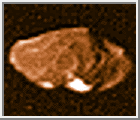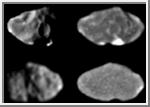
Jupiter V
Amalthea [am-al-THEE-uh] is one of Jupiter's smaller moons. It was named after the nymph who nursed the infant Jupiter with goats milk. It was discovered in 1892 by the American astronomer Edward Emerson Barnard while making observations from the Lick Observatory with a 36 inch (91 centimeter) refractory telescope. Amalthea was the last moon in the solar system to be discovered through direct visual observation. It was also the first moon of Jupiter to be discovered since Galileo's discovery of the four Galilean Moons in 1610.
Amalthea is extremely irregular, having dimensions of about 270x165x150 kilometers in diameter. It is heavily scarred by craters, some of which are extremely large relative to the size of the moon. Pan, the largest crater, measures 100 kilometers across and is at least 8 kilometers deep. Another crater, Gaea, measures 80 kilometers across and is probably twice as deep as Pan. Amalthea has two known mountains, Mons Lyctas and Mons Ida with local relief reaching up to 20 kilometers. The surface is dark and reddish in color apparently caused by a dusting of sulfur originating from Io's volcanoes. Bright patches of green appear on the major slopes of Amalthea. The nature of this color is currently unknown.
Amalthea rotates synchronously with its long, blunt axis pointed towards Jupiter. Because of Amalthea's close proximity to Jupiter, it is exposed to the intense Jovian radiation field. It continuously receives high doses of energetic ions, protons, and electrons produced by the Jovian magnetosphere. In addition it is bombarded with micrometeorites, and heavy sulfur, oxygen, and sodium ions that have been striped away from Io.
| Amalthea Statistics | |
|---|---|
| Discovered by | Edward Emerson Barnard |
| Date of discovery | 1892 |
| Mass (kg) | 7.17e+18 |
| Mass (Earth = 1) | 1.1998e-06 |
| Radius (km) | 135x84x75 |
| Radius (Earth = 1) | 2.1167e-02 |
| Mean density (gm/cm^3) | 1.8 |
| Mean distance from Jupiter (km) | 181,300 |
| Rotational period (days) | 0.498179 |
| Orbital period (days) | 0.498179 |
| Mean orbital velocity (km/sec) | 26.47 |
| Orbital eccentricity | 0.003 |
| Orbital inclination (degrees) | 0.40 |
| Escape velocity (km/sec) | 0.0842 |
| Visual geometric albedo | 0.05 |
| Magnitude (Vo) | 14.1 |
 Amalthea
Amalthea
This image of Amalthea was acquired by the Voyager 1 spacecraft on
March 5, 1979.
(Copyright Calvin J. Hamilton)
 Bright Streak on Amalthea
Bright Streak on Amalthea
These two images of Jupiter's small, irregularly shaped
moon Amalthea form a 'stereo pair' that helps scientists determine
this moon's shape and the topography of its surface features.
Features as small as 3.8 kilometers (2.4 miles) across can
be resolved in these images, making them among the
highest-resolution images ever taken of Amalthea.
The large impact crater visible in both images, near the
right-hand edge of Amalthea's disk, is about 40 kilometers
(about 29 miles) across; two ridges, tall enough to cast
shadows, extend from the top of the crater in a V-shape
reminiscent of a 'rabbit ears' television antenna. To the
left of these ridges, in the top center portion of Amalthea's disk, is
a second large impact crater similar in size to the first
crater. To the left of this second crater is a linear 'streak'
of relatively bright material about 50 kilometers (31 miles) long. In
previous spacecraft images of Amalthea taken from other viewing
directions, this bright feature was thought to be a small, round,
bright 'spot' and was given the name Ida. These
new images reveal for the first time that Ida is actually a
long, linear 'streak.' This bright streak may represent material
ejected during the formation of the adjacent impact crater,
or it may just mark the crest of a local ridge. Other patches
of relatively bright material can be seen elsewhere on Amalthea's
disk, although none of these other bright spots has
Ida's linear shape.
(Courtesy NASA/Cornell University)
 Best images yet of Thebe, Amalthea and Metis
Best images yet of Thebe, Amalthea and Metis
These images of the inner Jovian moons Thebe,
Amalthea, and Metis (left to right) are the
highest-resolution images ever obtained of these small, irregularly
shaped satellites. The images resolve surface features as small as 2 kilometers
(about 1.2 miles) across for Thebe; 2.4 kilometers (about 1.5
miles) across for Amalthea, and 3 kilometers (about
1.9 miles) across for Metis.
The moons are shown in their correct relative sizes, with sunlight
coming from the right. We are viewing the side of each moon that
faces permanently away from Jupiter, and
north is approximately up in all cases. The
large white region near the south pole of Amalthea marks the location
of the brightest patch of surface material seen anywhere on these
three moons. This unusual material, which
sits inside a large crater named Gaea, has been greatly overexposed;
accordingly, the white area on this image is somewhat larger than the
actual bright area on Amalthea. Note
also the 'scalloped' or 'sawtooth' shape of Amalthea's terminator
(the line between day and night, at the left-hand edge of Amalthea's
disk), which indicates that parts of this
satellite's surface are very rough, with many small hills and valleys.
(Courtesy NASA/Cornell University)
 Jupiter Small Satellite Montage
Jupiter Small Satellite Montage
This image is A montage of images of the small inner moons of Jupiter from
the camera onboard NASA's Galileo spacecraft shows the best
views obtained of these moons.
The top two images show the moon Thebe.
The next two images show the moon Amalthea; they were taken
with the Sun directly behind the observer, an alignment that
emphasizes patterns of intrinsically bright or dark
surface material. The third image from the top is a view of
Amalthea's leading side, the side of the moon that 'leads'
as Amalthea moves in its orbit around Jupiter. This image
looks 'noisy' because it was obtained serendipitously during
an observation of the Jovian satellite Io (Amalthea and Io
shared the same camera frame but the image was exposed
for bright Io rather than for the much darker Amalthea).
The fourth image from the top emphasizes prominent 'spots'
of relatively bright material that are located near the point on
Amalthea that faces permanently away from Jupiter. The bottom
image is a view of the tiny moon Metis.
(Courtesy NASA/Cornell University)
 Four Galileo Views Of Amalthea
Four Galileo Views Of Amalthea
These four images of Jupiter's moon, Amalthea, were taken by Galileo's
solid state imaging system at various times between February and June 1997.
North is approximately up in all cases. Amalthea, whose longest dimension
is approximately 247 kilometers (154 miles) across, is tidally locked so that
the same side of the satellite always points towards Jupiter, similar to
how the near side of our own Moon always points toward Earth. In such
a tidally locked state, one side of Amalthea always points in the direction
in which Amalthea moves as it orbits about Jupiter. This is called
the "leading side" of the moon and is shown in the top two images.
The opposite side of Amalthea, the "trailing side," is shown
in the bottom pair of images. The Sun illuminates the surface from the left
in the top left image and from the right in the bottom left image.
Such lighting geometries, similar to taking a picture from a high altitude
at sunrise or sunset, are excellent for viewing the topography
of the satellite's surface such as impact craters and hills. In the two
images on the right, however, the Sun is almost directly behind
the spacecraft. This latter geometry, similar to taking a picture
from a high altitude at noon, washes out topographic features and
emphasizes Amalthea's albedo (light/dark) patterns. It emphasizes
the presence of surface materials that are intrinsically brighter or darker
than their surroundings. The bright albedo spot that dominates
the top right image is located inside a large south polar crater named Gaea.
(Courtesy NASA/Cornell University)
 Topographic Map of Amalthea
Topographic Map of Amalthea
This is a topographic map of Amalthea. It is based upon the shape model of Phil
Stooke. As with all maps, it is the cartographer's interpretation;
not all features are necessarily certain given the limited data
available. This interpretation stretches the data as far as possible.
(Courtesy A. Tayfun Oner)
 Shaded Relief Map of Amalthea
Shaded Relief Map of Amalthea
This is a shaded relief map of Amalthea, a small satellite
of Jupiter. As with all maps, it is the cartographer's interpretation;
not all features are necessarily certain given the limited data
available. This interpretation stretches the data as far as possible.
(Courtesy Phil Stooke)
![]() Family Portrait of the Small Inner Satellites of Jupiter
Family Portrait of the Small Inner Satellites of Jupiter
These images, taken by Galileo's solid state imaging system between
November 1996 and June 1997, provide the first ever "family portrait"
of the four small, irregularly shaped moons that orbit Jupiter
in the zone between the planet's ring and the larger Galilean satellites.
The moons are shown in their correct relative sizes, with north approximately
up in all cases. From left to right, arranged in order of increasing distance
from Jupiter, are Metis (longest dimension is approximately 60 kilometers or
37 miles across), Adrastea (20 kilometers or 12 miles across), Amalthea
(247 kilometers or 154 miles across), and Thebe (116 kilometers or 72 miles
across). While Amalthea, the largest of these four tiny moons, was imaged
by NASA's two Voyager spacecraft in 1979 with a resolution comparable to what
is shown here, the new Galileo observations represent the first time that
Metis, Adrastea, and Thebe have been seen as more than points of light.
(Courtesy Cornell University)

 Jupiter
Jupiter Adrastea
Adrastea Thebe
Thebe